

Alexander the Great
Mercenary Greek Armies
Some folks have
commented that they wished the Mercenary Greek list was a “complete army
list.” The following guidelines allow players to use the mercenary units as a
full army list, of course if you don’t like my ideas you are certainly free to use
your own! As noted these ideas are for your own use with permission of your opponent and
can hardly be labeled as an official army list.
Greek
Mercenary Army
Xenophon and the
“Ten Thousand’s” amazing march out of
As
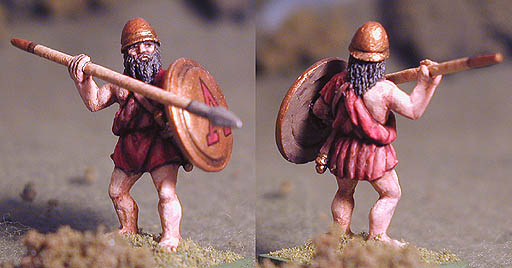
4th century Greek Mercenary Army List (Revised 05/08)
This list uses troop stats from the AtG Greek Mercenaries list on page 79 of AtG. The army uses oracles as described there.
The minimum size for a regiment is five models. There is no upper limit. One model in each unit may be upgraded to Leader (+5 pts) and one to a Musician (+5 pts). Oracles are used instead of unit Standards in this army.
SPECIAL RULES:
Trained Phalanx: A Trained Phalanx may not wheel while marching and must deduct
half its movement allowance when wheeling during Charge Movement. Drilled troops are
immune to this restriction. (Players may wish to use this phalanx rule for all Hoplites in
AtG, and Drilled Hoplites in WAB 1.5 for variety.)
Characters: Up
to 20% of the army total. The army must have an army general.
Cavalry: Up to 25%
of the total.
Hoplites, Light Infantry, and Skirmishers: At least 50% of the army total.
0-1 League hoplites are allowed and represent hastily formed local City-State militias, or
from local Greek colonies, they may not use the army General's leadership unless he joins
them.
Allies: Up to 10 % of
the army total may be taken from one of these lists as local ad-hoc allies:
Thrace: Lowland or Highland Thracian infantry, with 0-1
Cheiftain, 0-1 Thracian light cavalry.
or
End of Persia, [0-1 Takabara infantry, 0-1 Skirmish Cavalry, 0-1 Skirmishers,] or
[0-1 Lykian, 0-1 Carian, or 0-1 Bithynian Lowland infantry, with 0-1 Cheiftain.]
or
Illyrians, 0-1 warriors, 0-1 Cheiftain.
or
0-1 unit of Athenian allies as naval support (see page 52 AtG).
(Allies in this army may not use the Army general's leadership, or Oracles (exception
Athenians). Oracles may not be added to any combat involving friendly units with
standards)
CHARACTERS
Replace the characters in AtG with these:
1 ARMY GENERAL
M WS BS S
T W
I A Ld Pts
Spartan Strategos
4 6
5 4
4 3 6
3 9 175
Greek Strategos 4
5 3
3 4
3 5 3
9 155
Equipment: Sword. May have thrusting spear (free), shield
+2 pts, or a large shield +3 pts. May have light armour +2 pts, or heavy armour +3
pts. The Greek Strategos may ride a horse (free), his movement is increased to 6",
but may not use a shield.
Special Rules: Army General.
The Spartan strategos is drilled and stubborn.
If a Spartan strategos or xenagos is chosen then up to one unit of Spartan
Mercenary Hoplites must be fielded, they are chosen from the list below. At
least 50% of all hoplite points must include Spartan, Veterans, and/or Iphicratean units.
If a Greek Strategos is the Army General then the army must include at least one unit of
Veteran Hoplites and/or Iphicrateans.
OFFICERS
M WS BS S
T W I
A Ld Pts
Spartan xenagos
4 5
4 4
4 2 5
3 9 95
Greek xenagos 4
4 4
3 4
2 5 2
8 55
Equipment: Sword. May have
thrusting spear (free), shield +2 pts, or a large shield +3 pts. May have light
armour +2 pts, or heavy armour +3 pts. The Greek xenagos may ride a horse (free), his
movement is increased to 6", but he cannot use a shield.
Special Rules: The Spartan xenagos is drilled and stubborn. Up to one xenagos is allowed for each hoplite unit in the army.
SPECIAL CHARACTERS:
Chirisophus, is a Spartan
xenagos Xenophon, is
a Greek xenagos with leadership 9 (+15 pts)
Xenophon and Chirisophus commanded the “Ten Thousand” and must be taken
together. Chirisophus is the army general. Xenophon is a subordinate general (see AtG
page 10). 0-1 unit of psiloi may be Rhodian slingers (+1 pt in addition to
sling), these do not suffer the -1 to hit when shooting at long range. Allies:
May have Thracian, or Athenian allies.
Agesileus, is a Spartan
Strategos with leadership 10 (+20 pts) Allies: May have Persian Allies as listed.
May also have Thracians allies as listed above.
Iphicrates, is a Greek
Strategos. May include Veteran Peltasts.
Allies: May have Thracians and Illyrian allies as listed above.
http://monolith.dnsalias.org/~marsares/resource/pix/warfare/army/i_hoplit.jpg
Memnon of Rhodes, is a Greek
Strategos with leadership 10, (+25 pts) his leadership reverts back to 9 as a polemarch if
he is part of an "End of Persia" army.
Allies: May have End of Persia allies as listed above plus Bithynians, Carians and
Lykians.
CAVALRY
Add this unit type to the Cavalry lisitng:
0-1 Spartan Cavalry
Spartan cavalry 6 2 3 3 3 1 2 1 6 12
Equipment: Sword,
javelins or throwing spear.
Special Rules: Light Cavalry
Greek Horse are no longer 0-1
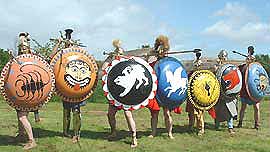
HOPLITES
Add this unit type to the Hoplite listing:
0-1 Spartan Mercenary Hoplites (xenoi/exiles)
Spartan xenoi/exiles 4 4 3 3 4 1 4 1 8 22
Equipment: Sword, thrusting
spear, large shield. May add Light Armour +2 pts.
Special Rules: Trained Phalanx. Drilled and Stubborn.
Veterans Hoplites are 0-1
Iphicrataean Hoplites are 0-1
Mercenary Hoplites
League Hoplites
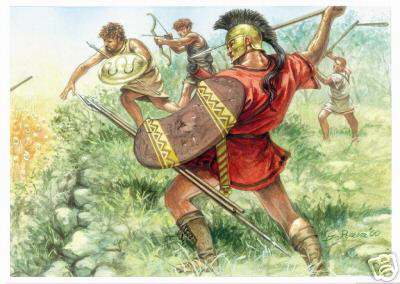
LIGHT INFANTRY AND SKIRMISHERS
Add this unit type to the Peltasts listing:
0-1 Veteran Peltasts
Veteran Peltasts 5 3 3 3 3 1 3 1 7 12
Equipment: Sword, javelins,
shield. May add thrusting spear +1 pt.
Special Rules: Light Infantry. Drilled. Feigned Flight.
These represent very highly trained or experienced Peltasts such as those under the command of Iphicrates at Lechaeum.
Peltast art:
http://community.imaginefx.com/fxpose/johnny_shumates_portfolio/picture10283.aspx
Peltasts
Psiloi
0-1 Cretans (May not outnumber any other infantry unit in the army)
(Skirmishers may not use oracles for combat bonuses in this army)
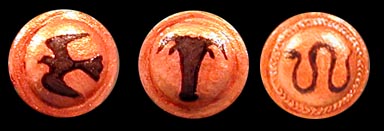
Sample armies:
Nemea 394 BC
The Battle of Nemea occured during the Corinthian War.
A large Theban confederation army of over 25,000 men had occupied the valley of Nemea while King Agesileus was away campaigning in Asia Minor.
The Spartans elected Aristodemus to lead a levy to halt this force while Agesileus was recalled from Asia. Xenophon states the Spartans had on hand 6000 Spartans and Perioikoi, and 7500 Peloponessian hoplites. Diodorus gives a more plausible figure of 23,000 hoplites. They were supported by 600 cavalry, 400 slingers, and 300 Cretan archers.
The Theban/Allied forces were probably more numerous and consisted of 6000 Hoplites
from Athens, Argos and Euboea provided 7000, Boeotia and Thebes 5000, and Corinth 3000.
They were supported by 800 Boeotian and 600 Athenian cavalry, plus another 150
cavalry of various states. The Allied skirmishers were numerous but neither side's
cavalry or skirmishers played any major role in the battle so their numbers are not
given by sources.
The Allies bickered about engaging and positioning, in the end the Thebans took the right flank and formed in depth. The battle lines were of equal length. As the armies approached each other the textbook hoplite 'shift to the right' occurred and by the time of contact both army's right wings were overlapping both left flanks. This meant the Thebans routed the Spartan allies, but on the right flank the Athenians were engaged with the Tegeans. They were enveloped by the Spartans who finding no enemy in front simply wheeled to their left and formed a new line, routing the Athenians. The Spartan allies ran to their camp losing more than 1000 killed, but the victorious Argives, Corinthians, and then Thebans, were taken in flank by the Spartans as they returned to their camp with shouldered arms seemingly victorious. The Spartans hit each group in flank routing them each time. At the end of the day 2800 of the confederation troops fell. The Spartans only lost eight men killed, as they reported to Agesileus-- noting only that a 'certain number' of the allies were killed (but who is counting eh?) So much for a linear slog fest eh??
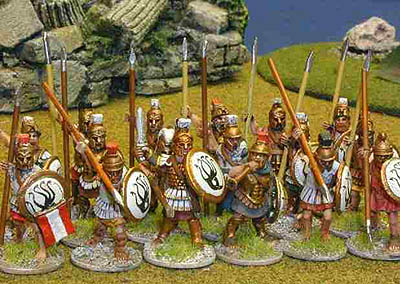
City-State variants for WAB 1.5 Greek armies:
These ideas are additions to the WAB 1.5 Greek army list as a guide
for selection of
City-State Greek armies.
Armies must choose an identity:
Spartan Thermopylae Army (479 BC):
This is a Greek Confederation list and uses the
Standard WAB 1.5 Ancient Greek list with these reccomendations:
* Must be lead by a Spartan General.
* No Cavalry allowed.
* 0-1 Spartan unit may be Sacred Band (300 Spartans- note there were also 900 Perioikoi
among the Spartan contingent of the 7000 man Greek army)
* No Cretan Archers, Peltasts or Thracian Peltasts
Notes on Thermopylae OOB (TBD)
Greek Army (480 BC):
This is a Greek Confederation list and uses the
Standard WAB 1.5 Ancient Greek list with these reccomendations:
* Must be lead by a Spartan General.
* No Cavalry allowed.
* No Sacred Band
* No Peltasts or Thracian Peltasts
* Use Cretan archers as the Athenian archer contingent
Notes on Plataea OOB (TBD)
Spartan/Peloponessian League Army:
* Must be lead by a Spartan General.
* At least one Spartan Hoplite unit must be chosen. Spartans are a Trained Phalanx (above)
* All hoplites may be drilled +2 pts (Arcadian and Peloponessian hoplites).
* No Sacred Band Hoplites.
* No Greek Heavy and up to 0-1 Greek Light Cavalry may be chosen.
* No Thebes/Thessaly Heavy Cavalry, No Thessaly/Thrace Light Cavalry.
* 0-1 Peltast unit (Skiritai), no Thracian Peltasts.
Theban/Boeotian League
* Must be lead by a General.
* 0-1 Sacred Band Hoplites, and are a Trained Phalanx (above)
* Massed Phalanx: 0-1 unit of Theban Hoplites may form in Massed Phalanx. They count
as Stubborn if their depth is five or greater and their frontage, in models, exceeds
their depth.
(For example a unit 6x5 gains the stubborn, a unit of 5x5 will not).
* 0-1 Greek Heavy and any Greek Light Cavalry may be chosen.
* Thebes/Thessaly Heavy Cavalry may be chosen without restriction.
Athens
* Must be lead by a General.
* No Spartan Hoplites or Sacred Bands are allowed.
* 0-1 Hoplite unit may upgrade to Epilektoi (Chosen) these are a Trained Phalanx and
Drilled +2 pts. (see above)
* Athenian Hoplites may become impetuous. If an enemy formed unit is within charge
range and could be legally charged, roll the unit's Ld, if it passes then there is no
effect and the unit need not roll again for Impetuosity for the rest of the game, if the
unit fails it must declare a charge.
* 0-1 Greek Heavy and 0-1 Greek Light Cavalry may be chosen.
* Thessaly/Thrace Light Cavalry may be chosen without restriction.
* Skirmishers with bows are unrestricted.
* 0-1 Peltast unit may be upgraded to Veteran Peltasts.
Argive
* Must be lead by a General.
* No Spartan Hoplites or Sacred Bands are allowed.
* 0-1 Hoplite unit may upgrade to Epilektoi (Chosen) these are a Trained Phalanx and
Drilled +2 pts. (see above)
* 0-1 Greek Heavy and 0-1 Greek Light Cavalry may be chosen.
http://mkatz.web.wesleyan.edu/thucydides_lecture/peltast_barb.gif
Phokian (TBD)
Euboaen (TBD)
Corinthian (TBD)
Thessalian (TBD)
Phokian (TBD)
Lamian War Alliance (TBD)
Greeks vs. Galatians (TBD)
Syracusan (TBD)

Special Optional Rule for WAB phalanx armies:
(May be applied to Mercenary Greeks, Macedonian, and WAB 1.5 Greek phalanxes as an optional rule with both player's consent)
Phalanx integrity:
The strength of the phalanx was enhanced when the individuals could depend on the shield
of the man on their right to cover his exposed right side. Just as individuals covered
individuals, units covered each other. The position of honor on the right was the
most exposed, but the tendency for the army to shift that way often caused an overlap
which was often the deciding factor in the hoplite action. This is described
in textbook fashion at the battle of the Nemea (394 BC).
Any phalanx unit that has both flanks covered may add +1 to their leadership value (to a maximum ld of 10). A flank is covered if a friendly phalanx, formed light infantry, or formed cavalry unit is within 3" measured from the front to front base edges, covering units must be generally facing the same direction to qualify . Phalanx units lose -1 leadership value if neither flank is covered. There is no effect if only one flank is covered. Fleeing units do not use this rule, and units attacked in flank or rear that are no longer allowed phalanx bonuses ignore this rule entirely.
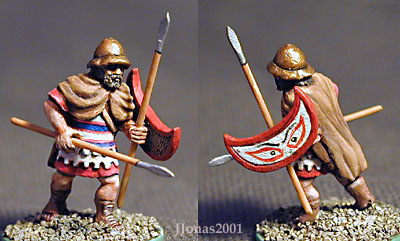
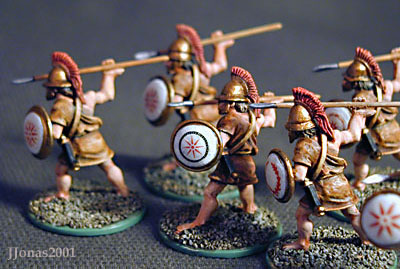
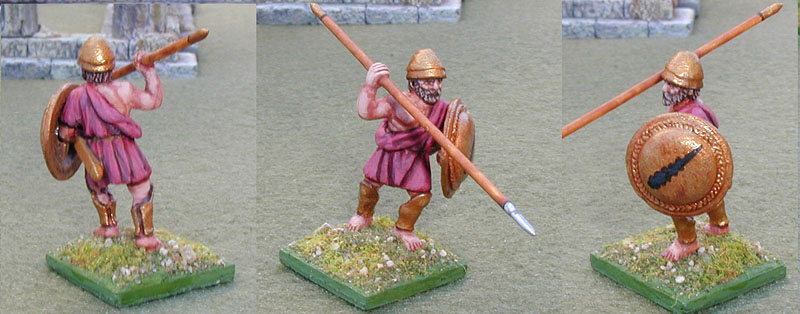
Historical background:
The famous "Ten Thousand" Greeks described by Xenophon were actually more than
that at the start of their journey into Persia and their retreat to the Black Sea.
Xenophon lists the commanders and units:
In commnad was Clearchus, a Spartan exile. His troops were operating in Hellespontine
Thrace, he was given 10,000 Darics by Cyrus to gather them and more troops.
The forces assembled in Celenae:
Aristippus, a Thessalian.
Xenias, an Arcadian, with 4000 hoplites.
Pasion, of Megara, 300 hoplites, and 300 peltasts.
Proxenus. a Boeotian, with 1500 hoplites, and 500 troops described as light infantry.
Sphaenetos, from Stymphalia, with 1000 hoplites.
Socrates, an Achaean, with 500 hoplites.
Menon, a Thessalian, with 1000 hoplites, and 500 peltasts (noted as Dolopes, Aenianes, and
Olynthians).
Clearchus, a Spartan with 1000 hoplites, 800 Thracian peltasts, and 200 Cretan archers.
Sosis, a Syracusan, with 300 hoplites.
Sophaenetus, and Arcadian, with 1000 hoplites.
Abrocomas, 400 hoplites
Chirisophus, 700 Spartan hoplites
Before the troops mustered Xenias and Pasion deserted. 40 Thracians were outfitted as
cavalry. 1000 Paphlagonian cavalry were attached as well.
This brought Claearchus' army to:
11,700 hoplites
2,300 peltasts archers and light troops
1040 cavalry
Read Xenophon's words at:
http://www.classicreader.com/read.php/sid.8/bookid.1803/sec.1
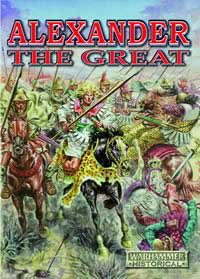
Where do you want to go next? Click on: Site Map
Back to AncientBattles.Com Home Page
05/08/08